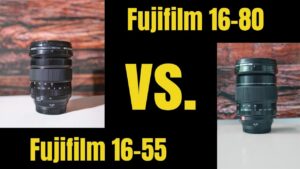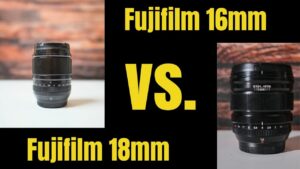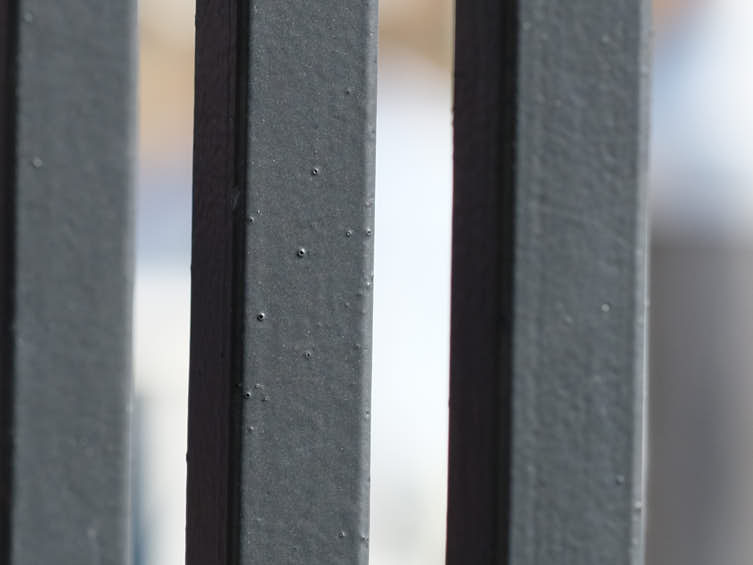Quick Facts about the Fujifilm 90mm F2 LM WR
- Weight: 1.19lbs/540 Grams
- Weather Sealed: Yes
- Filter Size: 62mm
- Angle of View: 17.9 Degrees
- Focusing Distance: 1.97 feet/60 centimeters
- Max Aperture: F2
- Minimum Aperture: F16
- Image Stabilization: No
- Mount System: Fuji X
- Price: $949
- Maximum Magnification: .2x
Table of Contents
Who is the 90mm F2 designed for?
The Fujifilm 90mm F2 was the premier portrait lens for the Fujifilm system. Additionally, some may argue that it still is.
Of all of the portrait, prime lenses within the Fujifilm system, the 90mm F2 has the fastest autofocus due to the quad-linear motors. It has a somewhat far focal length, which some people appreciate for photographing subjects such as street photography. Finally, it is built-well and sharp.
Now, that being said, it is only one-stop away from the 50-140 F2.8, the focal length can begin introduce distortion which makes the face appear fuller, and it does create some weird bokeh balls.
But this all being said, people will regularly use this focal length for landscapes. (With this lens, people use it to isolate specific subjects out. You have your wide, sweeping scene as the establishing shot. Then, you use this lens)
Of course, we will use this lens for outdoor photography.
Finally, it could be used as a semi-macro lens in a pinch.
What other XF Portrait Lenses Exist?
Fujifilm has now had over 10 years to develop their Fujifilm XF mount. This leaves us with numerous options such as…
The F1. Bokeh-licious. Premium Price. Inconsistent autofocus.
- Fujifilm XF 50mm F2
The budget “Fuji-cron” version of the portrait lens, the 50mm F2 has fast autofocusing speeds and it is weather resistant.
The 50mm F2 and the 23mm F2 make a formidable street combination.
- Fujifilm 56mm F1.2 (non-WR)
The first version of this lens is slow, but it can be found for less than $500 in a used state.
- Fujifilm 56mm F1.2 ADP
Something to do with smoother bokeh…
Noisy motors and slow autofocus detract from an almost perfect lens.
The jack of all trades for the telephoto zoom options, the Fujifilm 50-140 is the best-performing lens in regards to sharpness for a zoom.
Dials, Switches, Buttons, and More
There’s only one major button, and that is the aperture lock. It does have a marked aperture ring, however.
The aperture ring is not as loose as other Fujifilm lenses, so I am not worried about accidentally bumping against it and changing the aperture.
Build Quality
The overall build quality is very good, and it is made out of the typical higher-end Fujifilm lens material. (An example of lower-end build quality is the 18-120…)
Meanwhile, the manual focus ring on this 90mm F2 is very dampened, especially considering the other options available.
The only downfall of this manual focus ring is the amount of time it takes to go from minimum to infinity. There were at least three full rotations, which makes this lens almost impossible for manual-focus pulls.
Finally, you will hear the quad-linear magnets in the lens when the lens is turned off. I don’t expect to be shaking this lens ever, but it’s something to note. The autofocus motor is almost silent. You can hear it a bit, but not unless you put your ear up to the lens.
90mm F2 Color Fringing
In regards to color-fringing, there is some slight color fringing at F2. As you stop down to 2.8, the color fringing is starting to disappear. At F4, the purple and green fringing is completely gone, which is great!
But I do have two points. First, the two stops of color fringing is common amongst Fujifilm lenses. (And really all lenses if you photograph at the minimum aperture.) However, it could be problematic for some that the 90mm F2’s fringing does not go away by F4.
On something like the 56mm F1.2, we have an extra stop-and-a-half of light to play with. Therefore, the fringing will go away at around 2.8 usually… But I digress.
(Just a heads up: Light does not create color-fringing. It’s the lens’s optical design. Yes, I know!)
This all being said, I cropped by over 100%. I hate to be that person, but you have to ask yourself if you are really going to notice something that extreme.
Bokeh Review
Most people are going to fail to notice anything spectacular with the bokeh, as it’s a common depth of field that event photographers use.
A 70-200mm F2.8 full-frame will have similar results to this lens. (Keep this in mind as you debate full-frame vs APS-C.)
The transitions from subject to the foreground and background are decent. And with this focal length, you separate your subject a good deal from the background.
This aperture/focal length combination can lend itself to busyness within trees and other bushes/greenery. Yet, it’s avoidable depending on the your photography skills and knowledge of how to frame.
Bokeh Balls Review
As a result of the seven aperture blades, the 90mm F2 bokeh balls are sub-par beginning at F2.8. Meanwhile, at F4, there is a very evident heptagon appearance. (This is evident in the vignette photo below, too.)
Finally, I found that there might be a slight tendency at F2 for the bokeh to cat eye, but only in the extreme corners.
Brick Wall Sharpness Test
Center Sharpness
- Starting at F2, the center sharpness on the 90mm F2 is excellent.
- I did not see any noticeable improvement as I stopped down to F4 and F5.6.
- However, by examining the line in the top 1/3 of the frame, I did feel like there was a slight drop of image quality at F8.
- By the time you stop down around F11, diffraction hits all of a sudden, and it’s very noticeable.
- The overall sharpness of the Fujifilm 90mm F2 performs amicably/excellent in the corners as well. So much so, I would imagine that it performs about the same as the center of the frame.
- Around F2, the image is sharp, but we continue to see no noticeable improvement.
- Finally, there might be a slight drop of image quality at F8, and it becomes noticeable at F11.
All around, I think most people will be happy with the results from this lens.
Autofocus Tests
Photo Autofocus
All things considered, I did find the autofocus to be quick. So much so, out of every Fujifilm telephoto lens, I would rank the speed at #1 or #2.
In dimly-lit situations, you *might see the autofocus transition anywhere between one to three different steps. However, anything later than X-Trans IV should fix this.
Video Autofocus (Continuous Tracking)
Tracking Sensitivity +2
AF Speed +3
4k60 w/1.18x crop X-T4
I found the tracking and subject recognition to be excellent in video mode, too.
It was quick to notice my face, and there was not a lot of hesitancy.
Distortion Test
From the naked eye, I did not notice any distortion in the RAF files.
However, it wouldn’t be uncommon for the focal length and barrel design to have “some” pincushion distortion.
The corrected version above was with the 90mm F2’s Capture One Lens Correction Profile Turned on. And the “not corrected” was with it off and the slider removed.
I did notice that the JPEG version and the RAF with the lens correction profile looked identical, too!
Vignetting
Vignetting is minimal, too. Here’s a photo with the vignetting automatically removed.
Sunstars, Ghosting, and Flaring
The sunstars are surprisingly good for this lens. However, the ghosting is problematic.
Sometimes you can be creative with flare or ghosts in your image, but with this one it is much more limited.
I found that the ghosts take on the shape of the iris, which is that heptagon is the frame.
You are going to be relying on the lens hood pretty extensively.
Macro Test
With a maximum reproduction ratio of .2x, it is a mediocre macro lens. It is not as good as lenses that are dedicated solely to that purpose such as the 80mm F2.8.
However, when you do combine the F2 aperture along with a 90/135mm Focal Length (which is very narrow… about 18 degrees), AND a focusing distance which is only 10 centimeters further than the 56mm F1.2 WR, (FOV: 29 Degrees) the 90mm is probably the one portrait lens that actually could wear two hats.
At the very least, you will be able to fill the frame with the right subject.
Sample Images
Pros
Autofocusing Speed
All around, this is one of the fastest lenses in regards to autofocusing speed, which is impressive when you consider its release date. (2015)
The 90mm does make you question Fujifilm’s other lens design choices, however. It took over 5 years for them to start thinking about focus speed again.
Sharpness is Excellent
Across the frame, the sharpness is excellent at every aperture from F2 until F8. There is no noticeable difference between the center and corner sharpness.
Minimal Distortion & Vignetting
You probably will not notice this too much. However, it’s nice to know that in post-production, you won’t run into any cropping. What you see on the back of the camera is what you will get.
Cons
Expensive Lens
At $949, it’s hard to justify a lens at this focal length. There is a reason this is one of the most-rebated lenses during the Spring and Winter sales.
Focal Length
The focal length is very limiting, as this lens is strictly for outdoor work. Sure, it might lens itself as a great landscape lens. But if you have never used this focal length, there is a steep learning curve.
Seven-Bladed Aperture
It shows up in a variety of ways. The bokeh balls, the ghosting, the bokeh depending on the background. It’s disappointing and hard to justify.
My Rating
Price: 4/5
-1 for the aperture blades impeding on the ghosting and bokeh balls.
Functionality: 4/5
We lost an entre point due to not being able to rely on this lens indoors. I understand that some people are going to be aware of this attribute.
Style: 5/5
Total: 17/20 or about 85%
I think most people are going to be happy with the results from this lens, once you know how to use it. The 90mm F2 is sharp across the entire frame, the fringing is expected, and the bokeh is normal. It’s just hard for me to give a specialized lens anything above a 85%.

Fujifilm 16-55 vs 16-80mm F4
The Fujifilm 16-80mm F4 and 16-55mm F2.8 are some of the most expensive “normal” zoom lenses that Fuji makes. Is the 16-80 so bad? And is the 16-55 better?

Fujifilm 18mm vs 16mm F1.4
Two of the best performing wide-angle, XF lenses made by Fujifilm, the 18mm and 16mm should be a comparison that most people think about. But why don’t they?

Fujifilm 18mm F1.4 Review
If you have ever wanted to test the new, Fujifilm 18mm F1.4, but you haven’t had the money.. And how does the 18mm F1.4 vs 16mm F1.4 compare?








































